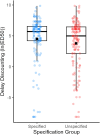Perceived reward certainty in the assessment of delay discounting
- PMID: 40924801
- PMCID: PMC12419681
- DOI: 10.1002/jeab.70044
Perceived reward certainty in the assessment of delay discounting
Abstract
Reward delays are often associated with reduced probability of reward, although standard assessments of delay discounting do not specify degree of reward certainty. Thus, the extent to which estimates of delay discounting are influenced by uncontrolled variance in perceived reward certainty remains unclear. Here we examine 370 participants who were randomly assigned to complete a delay discounting task when reward certainty was either unspecified (n=184) or specified as 100% (n = 186) in the task trials and task instructions. We examined potential group differences in (a) perceived reward certainty across a range of delays, (b) delay discounting, and (c) associations between perceived reward certainty and delay discounting. Delay significantly reduced perceived reward certainty in both groups, although delay did not significantly interact with group to affect perceived certainty. Despite higher perceived reward certainty in the specified group, no significant group difference in delay discounting was observed. Higher perceived reward certainty was associated with lower delay discounting in both groups. However, we found no evidence that specifying reward certainty influences estimates of delay discounting. Future research should examine whether perceived reward certainty moderates associations between delay discounting and health behavior and whether perceived reward certainty is impacted by interventions that change delay discounting.
Keywords: delay discounting; framing; perceived reward certainty; uncertainty.
© 2025 The Author(s). Journal of the Experimental Analysis of Behavior published by Wiley Periodicals LLC on behalf of Society for the Experimental Analysis of Behavior.
Conflict of interest statement
None of the authors have a conflict of interest to disclose.
Figures





References
-
- Białaszek, W. , Marcowski, P. , & Ostaszewski, P. (2021). Risk inherent in delay accounts for magnitude effects in intertemporal decision making. Current Psychology, 40, 1680‐1695. 10.1007/s12144-018-0092-4 - DOI
-
- Craft, W. H. , Tegge, A. N. , Freitas‐Lemos, R. , Tomlinson, D. C. , & Bickel, W. K. (2022). Are poor quality data just random responses?: A crowdsourced study of delay discounting in alcohol use disorder. Experimental and Clinical Psychopharmacology. 30(4). 409‐414. 10.1037/pha0000549 - DOI - PMC - PubMed
MeSH terms
Grants and funding
LinkOut - more resources
Full Text Sources

